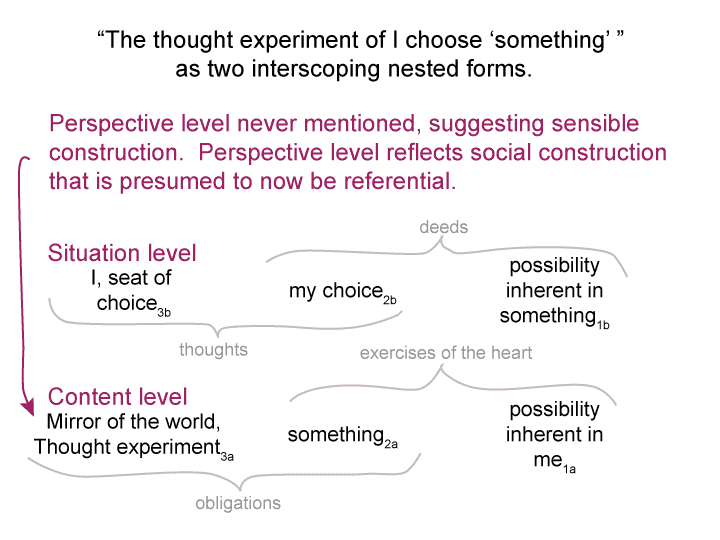Man and Sin by Piet Schoonenberg (1964) 2.3 SE
Summary of text [comment] pages 83 and 84
[Some people do not like the word “Satan.
Perhaps another word for the perspective level is the German word: Zeitgeist.
“Zeit” means ‘of the times’.
“Geist” means ‘spirit’.
Perhaps, Zeitgeist could become a technical word:
geistProgressive]
Man and Sin by Piet Schoonenberg (1964) 2.3 SD
Summary of text [comment] pages 83 and 84
[The previous blog raises an interesting question:
What puts ‘the thought experiment where ‘I choose something’‘ into perspective?
Note Schoonenberg’s refrain: In our freedom, we serve God or Satan.
Both perspectives appear in the mirror of the world.]
Man and Sin by Piet Schoonenberg (1964) 2.3 SC
Summary of text [comment] pages 83 and 84
[The thought experiment produced two models.
One of these models consisted of two interscoping nested forms, corresponding to content and situation. A third level, perspective, always available and influential, is never mentioned.
This arrangement indicates sensible construction, as opposed to social construction.
Man and Sin: A Theological View was originally published in 1962. The author was Dutch Jesuit theologian. He mimicked the contemporary social sciences by trying to be sensical. Sensical material is situated by sensible construction.
The irony of sensible construction is that it does not challenge the perspective level.]
Man and Sin by Piet Schoonenberg (1964) 2.3 SB
Summary of text [comment] pages 83 and 84
Note Schoonenberg’s comment: In our freedom, we serve God or Satan.
[For the past few months, my blogs riffed off of page 83.
The thought experiment where I choose ‘something’ served as a tool for investigating Schoonenberg’s passage on responsibility and freedom.
Redemption is freely choosing to be responsible.]
Man and Sin by Piet Schoonenberg (1964) 2.3 SA
[Normal contexts follow the logic of exclusion. However, exclusion is difficult to attain.
Sin enters through destructive ideas in the mirror of the world.
Law enters through the self-justification of I, seat of choice.]
Man and Sin by Piet Schoonenberg (1964) 2.3 RZ
[My associations show that the bondage of personal sin already reflects a normal context (the thought experiment, the mirror of the world) both beyond and within the person.
Perhaps, the bondage of sin and the bondage of a religionsovereign are not so different.]
Man and Sin by Piet Schoonenberg (1964) 2.3 RY
[At this part of his text, Schoonenberg focuses on personal sins. He points to the bondage of sin for the individual.
Yet, in the hazy distance, the words of an (infra)sovereign religion linger.]
Man and Sin by Piet Schoonenberg (1964) 2.3 RX
Summary of text [comment] pages 83 and 84
Schoonenberg writes that, when the Son of God invites us to the service of the Father, that service will have a liberating character. We are redeemed. We are free from that other servitude that may be called “bondage”.
Man and Sin by Piet Schoonenberg (1964) 2.3 RW
Summary of text [comment] pages 83 and 84
[Certainly, the term of ‘words3a(2a’ may not be sufficient.
I wonder what term would fit better?]

